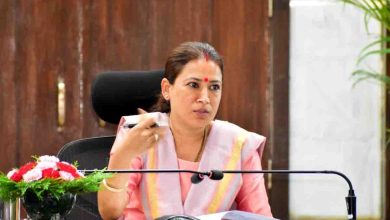Reviving Himalayan Heritage: Ukhand’s Journey from Forgotten Grains to Superfood Capital

PNS/ DEHRADUN
Nestled in the heart of the Himalayas, Uttarakhand is a land of breathtaking beauty, rich culture and a profound agricultural heritage. Its villages once thrived on a sustainable and diverse food system rooted in traditional crops like barnyard millet (jhangora), finger millet (mandua), horse gram (gahat), and buckwheat (kuttu). These nutrient-rich grains, cultivated through the ancient Bara Anaaja system (growing 12 or more crops on the same land), not only sustained generations but also enriched the soil.
However, the winds of change- brought by modernisation and the commercialisation of agriculture- displaced these native grains. Traders and colonial influences branded them as ‘animal feed’ or ‘food for the poor,’ nudging them out of the kitchens of the hills. In their place, refined staples like wheat and rice gained prominence, not because they were better suited for the terrain or the people but because they were more profitable for trade and easier to industrialise.
The Decline of Traditional Grains
The Green Revolution, which swept across India in the mid-20th century, further deepened this divide. While it achieved the objective of feeding a growing population, it did so at the expense of biodiversity. High-yielding varieties of wheat and rice dominated the agricultural landscape, pushing traditional crops to the margins. In Uttarakhand, farmers shifted away from cultivating hardy native grains to these new staples, which demanded more water, fertilisers, and pesticides—resources that were scarce in the mountainous terrain.
This shift didn’t just impact the diet and health of the region’s people. It also left a significant environmental footprint. Traditional grains, perfectly suited to Uttarakhand’s hilly terrain and unpredictable climate, required fewer resources and enriched the soil. Their decline marked the beginning of a fragile food system heavily reliant on external inputs.
The Superfood Revival: Irony of Capitalism
Fast forward to today, the world is grappling with lifestyle diseases like diabetes and obesity. India alone is home to over 101 million diabetics with another 136 million at risk. These alarming statistics have brought traditional grains back into focus—not as the ‘poor man’s food’ they were once mocked as, but as ‘superfoods’ celebrated for their high nutritional value, low glycemic index and climate resilience.
Ironically, the same grains that were once easily accessible to Uttarakhand’s poorest communities are now rebranded and sold at premium prices under the ‘organic’ and ‘superfood’ labels. Big corporations and urban markets have turned what was once a household staple into an exclusive luxury item. The people who originally cultivated and consumed these grains are now unable to afford them.
Ukhand’s Opportunity to Lead the Change

For Uttarakhand, this is a moment of both reflection and action. The State is uniquely positioned to reclaim its heritage and turn the tide by making these traditional crops accessible and profitable for its people. Here is how the Uttarakhand government and its communities can lead the revival:
1. Policy Interventions and Incentives
The government can introduce subsidies for farmers growing traditional grains, similar to those provided for wheat and rice. Introduction of Millet Missions and Crop Diversity Schemes can provide financial support, high-quality seeds and training for sustainable farming practices.
2. Branding and Marketing
Uttarakhand’s traditional grains should be marketed under a cohesive regional brand, such as ‘Himalayan Superfoods’. These can be promoted not just within India but globally as part of the sustainable and health food movement. Festivals, expos and social media campaigns can celebrate and create awareness around these crops.
3. Strengthening Local Markets
By establishing farmer-producer organisations (FPOs) and cooperatives, the government can help small farmers pool resources, negotiate better prices and bypass middlemen. Local markets in tourist-heavy areas like Dehradun, Mussoorie, and Nainital can become hubs for selling these grains directly to consumers.
4. Incorporating Traditional Crops in Government Schemes
The government can ensure that mandua, jhangora, and other traditional grains are included in mid-day meal programmes, public distribution systems (PDS), and nutritional campaigns. This will boost local demand and improve community health.
5. Educational and Awareness Campaigns
Reviving traditional grains requires educating both consumers and farmers. Workshops, culinary festivals, and awareness drives can highlight the health benefits and economic potential of these crops. Schools can introduce traditional recipes in their curriculums to foster appreciation among the younger generation.
6. Eco-Tourism Integration
As a State known for its tourism, Uttarakhand can integrate its agricultural heritage into its eco-tourism initiatives. Tourists can be offered immersive experiences like participating in traditional farming, cooking with local grains and learning about their cultural significance.
Economic Opportunities for the People
A focused effort to revive traditional grains can create multiple economic opportunities in Uttarakhand:
• Employment Generation: Promoting small-scale agro-industries for cleaning, packaging and processing traditional grains can provide employment to rural communities.
• Value Addition: Entrepreneurs can explore value-added products such as millet-based snacks, gluten-free flours and energy bars, catering to the growing health-conscious market.
• Export Potential: With rising global demand for organic and climate-resilient crops, Uttarakhand can position itself as a key exporter of millets and traditional grains.
Uttarakhand’s traditional grains are more than just food; they are a testament to the wisdom of our ancestors who understood the delicate balance between health, agriculture and nature. While capitalism has turned these grains into expensive commodities, the State has the power to reclaim and democratise them.
By reviving traditional farming, fostering sustainable practices and creating an ecosystem where these crops can thrive, Uttarakhand can not only address pressing health and environmental challenges but also empower its rural communities. The journey to rediscovering these lost grains of the hills is not just about food; it is about preserving a legacy and building a future rooted in sustainability, equity and pride in our heritage.






